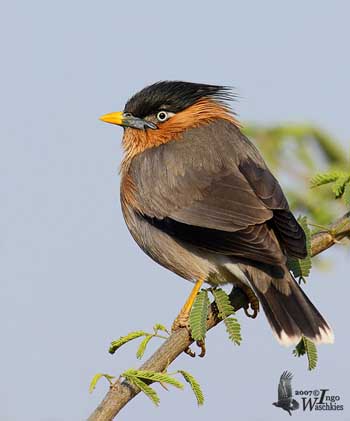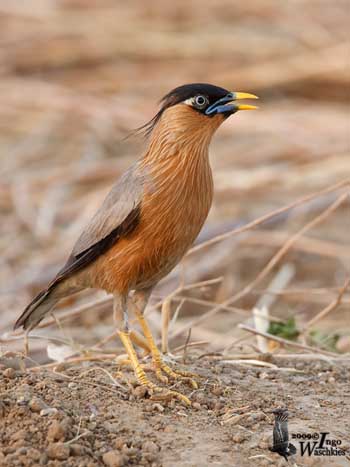
Brahminy Starling
Sturnia pagodarum
Passeriforme Order – Sturnidae Family
BIOMETRICS:
Length: 20 cm
Weight: 40-54 g
DESCRIPTION:
This handsome starling from India and Nepal is named “pagodarum” in its scientific name, from its habits for perching on temple pagodas in S India. As other Sturnidae, the Brahminy Starling is very gregarious and often seen in large flocks at roosts.
The adult has long loose crest formed by elongate crown feathers. On nape and upper breast, feathers are also hackled. On the head, forehead and crown are glossy black. The nape is cinnamon with fine shaft streaks. This part is often concealed by the long crest feathers.
On the upperparts, mantle, back and rump are brownish-grey. On the upperwing, coverts are grey tinged brown, and primaries are dull blackish with some white at base. The tail is grey-brown with white tips except on central pair.
The underparts are cinnamon, including the neck sides. On the upper breast, some pale shafts give streaked effect. Flanks, vent and undertail-coverts are greyer.
The bill is yellow with bluish base. Eyes are pale greenish-yellow. Legs and feet are yellow.
Fr: Etourneau des pagodes
All : Pagodenstar
Esp : Estornino de las Pagodas
Ital : Storno delle pagode
Nd: Pagodespreeuw
Sd: Pagodstare
Photographers:
Jean Michel Fenerole
Photos d’Oiseaux du monde
Niraj V. Mistry
Photo Galleries
Ingo Waschkies
Bird Photography
Text by Nicole Bouglouan
Sources:
HANDBOOK OF THE BIRDS OF THE WORLD Vol 14 by Josep del Hoyo-Andrew Elliot-David Christie - Lynx Edicions –
ISBN: 9788496553507
A Field Guide to the Birds of South-East Asia by Craig Robson. New Holland Publishers. ISBN: 9781780090498
BirdLife International (BirdLife International)
Wikipedia, the free encyclopaedia
XENO-CANTO – Sharing Birds sounds from around the world

The female is very similar but she has shorter crest and hackles, buffer underparts and grey eyes.
The juvenile has browner back and crown, and lacks crest and hackles. It resembles female but it is duller.
VOICE: SOUNDS BY XENO-CANTO
The Brahminy Starling’s calls are harsh shrieks rapidly repeated in series which can be preceded by nasal note. The alarm call is a grating “churr” uttered in short series.
The song is short, a drawn-out gurgling sound, followed by louder bubbling yodel “gu-u-weerh-kwurti-kwee-ah”.
The loud territorial call is given in short phrases, whereas the advertising call is softer. During the courtship displays, both mates utter extended song with complicated structure. They also include mimicry of other bird species.
Songs are given from perch or from the ground.
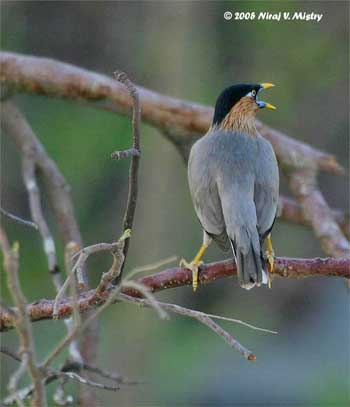
HABITAT:
The Brahminy Starling occurs in dry open country and lowlands, open deciduous forest, scrub and cultivated areas. It is often seen near habitations and in waterlogged areas. The species is visible from lowlands up to 1800 metres of elevation.
RANGE:
The Brahminy Starling is found in NE Afghanistan to W Nepal and W Bengal, S to E Pakistan and peninsular India. There are non-breeding visitors in Sri Lanka.
This species is resident in most part of the range, with some seasonal movements probably related to monsoon.
BEHAVIOUR:
The Brahminy Starling feeds mainly on insects and other invertebrates, but it also takes plant matter such as fruits and berries, flowers and nectar. Spiders, snails, earthworms, large insects, butterflies, moths and caterpillars are also part of its diet.
The chicks are fed with animal food and some plant matter.
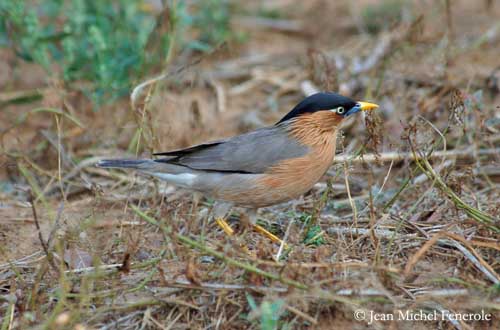
The Brahminy Starling has brush-tipped tongue, typical of nectarivorous birds, but it also shows an adaptation to open the bill forcefully when probing or hunting.
It forages mainly on the ground, often in wet pastures among cattle. It walks rather than hops. Small groups can be seen foraging in flowering and fruiting trees, and hunting insects in the canopy.
They may forage with other Sturnidae species and also roost communally and in large flocks in trees, shrubs or reedbeds during the non-breeding season.
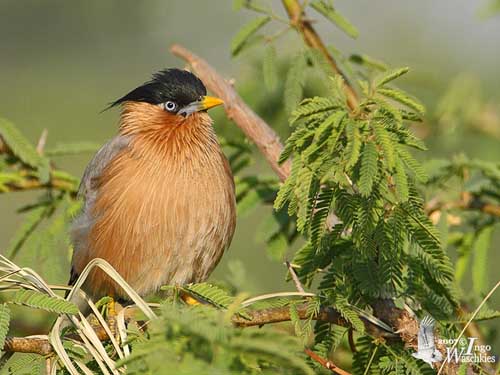
But during the breeding period, the male performs some displays which take place on the ground. It adopts a standing erect posture with puffed out crest and breast feathers, and moves the fanned tail up and down. These displays are accompanied by songs.
FLIGHT: Any available information.
REPRODUCTION:
The breeding season occurs between April and August, usually earlier in the southern part of the range.
This species may produce up to 2-3 broods per season. They are monogamous, and can be solitary or colonial nesters according to the available nesting holes.
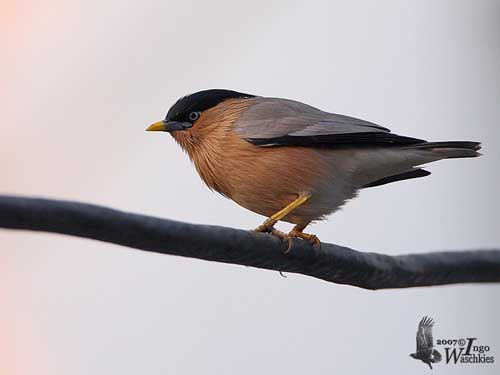
The nest is placed in hole in tree, in abandoned woodpecker nest or a hole in wall or roof, and even in nest-box. Inside the hole, the nest is built by both sexes. This is an untidy structure made with dry grass, dead leaves, paper and others. It is lined with finer and softer materials.
The female lays 3-5 pale blue eggs. Both sexes incubate during about 12 days, but usually, the female incubates more than the male. It may feed her at nest sometimes. The chicks are fed by both parents and fledge 18-21 days after hatching.
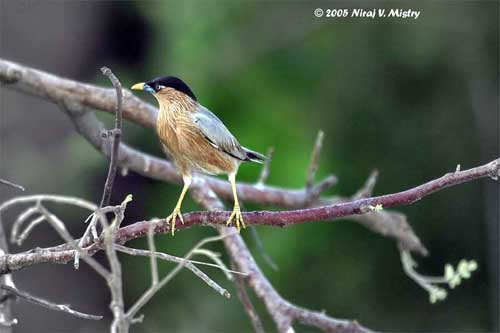
DIET:
The Brahminy Starling feeds primarily on insects such as grasshoppers and crickets, cockroaches, termites, bugs, butterflies, moths and caterpillars, flies, ants, bees and beetles. It also takes spiders, snails and earthworms. It consumes plant matter such as fruits and berries from various plant species, flower parts and nectar.
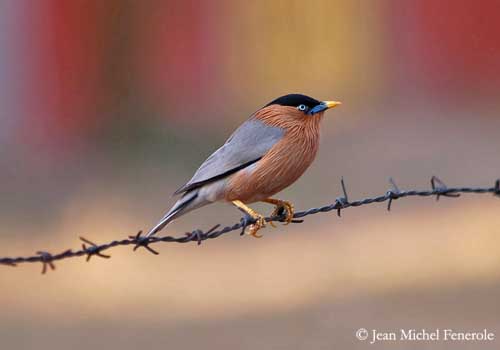
PROTECTION / THREATS / STATUS:
The Brahminy Starling is locally common. It may expand in the northern part of the range.
The species is not currently threatened.
